
International Research Journal of Engineering and Technology (IRJET) e-ISSN: 2395-0056
Volume: 11 Issue: 11 | Nov 2024 www.irjet.net p-ISSN: 2395-0072


International Research Journal of Engineering and Technology (IRJET) e-ISSN: 2395-0056
Volume: 11 Issue: 11 | Nov 2024 www.irjet.net p-ISSN: 2395-0072
Pranav N. Sangave#1 , Dr. Ganesh D. Bhutkar#2 , Varad P. Uplanchiwar#3 , Vedika V. Sontakke#4 , Shrutika C. Gade#5
#Vishwakarma Institute of Technology, Pune ***
Abstract With the increasing adoption of precision agriculture and the rapid advancements in machine learning technologies,thereisagrowingneedtobridgethegapbetween artificial intelligence (AI) and human expertise in the agricultural domain. This research paper presents a novel platform that integrates machine learning models with human decision-making processes for crop optimization. The proposed solution aims to assist farmers, particularly new and inexperienced ones, in making informed decisions about crop selectionbyleveragingbothAI-poweredrecommendationsand the collective knowledge of local farming communities. The research methodology involves collecting and preprocessing historical agricultural data, training, and validating the machine learning models, developing a user-friendly Android applicationforfarmerinteraction,andconductingcomparative analyses between AI-generated recommendations and human decisions. The platform's performance is evaluated based on metrics such as prediction accuracy, user satisfaction, and the potential for improving crop yields and profitability. The proposed platform contributes to the field of human-computer interaction (HCI) and machine learning in agriculture by demonstrating the synergistic potential of combining AI capabilities with human expertise. By providing a comprehensive decision-support system that leverages both data-driveninsightsandlocalknowledge,thisresearchaimsto enhance crop selection processes, optimize agricultural practices, and ultimately contribute to sustainable food production.
Keywords:PrecisionAgriculture,CropOptimization,Machine Learning, Random Forest, Arima Time Series, Crop Price Forecasting, Farmer Knowledge Interaction, Sustainable Agriculture,Android,LocalKnowledgeAlignment
n today's digital age, the seamless integration of technology into agricultural practices has brought both opportunities and challenges. One promising aspect is the rise of machine learningandartificialintelligencetechnologiesinthedomain of precision agriculture. These technological advancements arefascinatingintherealmofcropoptimization.
As we explore the world of agricultural intelligence, it is disheartening to witness how the potential of these technologieshasbeenunderutilized,turningthemfromtools of innovation into missed opportunities for enhancing
agricultural productivity. The concept of leveraging datadriven insights and local knowledge for crop selection is not as recent as one might think. Examples of such approaches date back centuries, when farmers relied solely on generational wisdom and manual techniques to make decisions about crop types based on their specific soil conditionsandclimaticpatterns.
Farmers, both experienced and novice, have found themselvesgrapplingwiththechallengeofselectingthemost suitable crops for their unique circumstances. These instances highlight the growing need for robust decisionsupport systems that can harmonize the power of machine learning with the invaluable expertise of local farming communities, ensuring informed crop selection and mitigatingpotentialriskstoyieldsandprofitability.
In this era of rapid technological advancements, addressing the challenges of crop optimization through a synergistic approach becomes crucial. The following exploration delves into the increasing need for agricultural intelligence systems that bridge the gap between machine learning and human expertise, shedding light on the challengesfacedbyfarmersacrossvariouscontexts,butalso outlinestheobjectivesoftheproposedsolutioninmitigating thelimitationsofexistingapproaches.
Intherealmofagriculturalintelligence,oursystemstands outbyaddressingthelimitationsofexistingsolutions.Unlike standaloneapproachesthatfocusoneithermachinelearning models or human expertise, our research takes a holistic approach. Developing an integrated system that leverages Random Forest and ARIMA time series models for crop prediction and price forecasting, while seamlessly incorporating a farmer feedback module for knowledge sharing. This comprehensive solution combines advanced machine learning algorithms with a human-centered approach. By unifying these elements, the goal is to offer farmers a simple, all-in-one tool through a user-friendly interface for accurate and informed crop selection. The integratedapproachenhancestheoveralleffectivenessofthe system in optimizing agricultural practices, providing a robustsolutionthatharnessesthepowerofbothdata-driven insightsandlocalknowledge.

International Research Journal of Engineering and Technology (IRJET) e-ISSN: 2395-0056
Volume: 11 Issue: 11 | Nov 2024 www.irjet.net p-ISSN: 2395-0072
The following are the major objectives of this research on agriculturalintelligence:
To develop an advanced crop optimization system using machine learning and farmer knowledge integration for predicting suitable crop types and forecastingcropprices.
To implement algorithms that combine AI-powered recommendations with farmer feedback and experiences.
Togeneratecropsuitabilityassessmentsbasedonuser inputsandclimaticconditionsusingAImodels.
To analyze the impact of the integrated approach on agricultural productivity, profitability, and sustainability, and integrate findings into comprehensive documentation for knowledge dissemination.
Byaccomplishingtheseobjectives,theaimofourresearch work is to offer farmers a comprehensive and integrated system that proactively addresses the challenges of crop optimization by bridging the gap between machine learning and human expertise, ultimately contributing to sustainable agricultural practices and improved livelihoods for farming communitiesworldwide.
Several research papers related with crop optimization and human-computer interaction have been studied and discussedinthissection.
The first paper proposes a system using Random Forest and SVM algorithms for soil classification, crop yield prediction, and fertilizer recommendation based on soil nutrients, crop data, and location [1]. While effective, our proposed agriculture intelligence system offers significant improvements like integration of farmer knowledge through an interactive broadcasting system, crop suitability assessment, while bridging the gap between machine learning and human expertise for optimized crop selection, andimprovedlivelihoodsforagriculturalcommunities.
ThesecondpaperproposesawebapplicationAgriBotthat assists Indian farmers by recommending suitable crops basedonregion-specificconditions.Itusesmachinelearning algorithms like K-Nearest Neighbor, Decision Tree, and RandomForest,toanalyzesoil,weather,andcropdata.High accuracy in crop recommendations was achieved improving thedecision-makingprocess[2].Ourprojectincorporatesan androidapplication,allowingeasyanduser-friendlyaccessto farmers, many of whom are more familiar with using smartphonesthancomputersorlaptops.
The third paper presents a system for crop recommendation in precision agriculture using machine learningtechniques.Itcollectsdataonsoil,climate,andcrop types, preprocesses it, and employs the K-Nearest Neighbor algorithmforprediction.Thesystemachievesan accuracyof 89.45% in crop recommendation [3]. Our project aims to integratebothmachinelearningmodelsandhumanexpertise through farmer feedback. It utilizes algorithms like Random Forest and ARIMA, along with farmer broadcasting system forcollaborativedecision-making.
The fourth paper presents the integration of HumanComputer Interaction (HCI) principles into agricultural education, emphasizing interactive learning tools and technologies. However, it does not specifically mention the use of algorithms or provide accuracy of algorithms or provide accuracy metrics [4]. Our project focuses on optimizingcropselectionthroughtheintegrationofmachine learningalgorithmsandfarmerfeedbackmechanisms.
The fifth paper presents a framework for precision agriculture using wireless sensor networks (WSNs) to monitor environmental conditions. It discusses data collection, analysis, and decision-making processes but does not specify algorithms or accuracy metrics [5]. Our project demonstratestheaccuracyofRandomForestmodelforcrop recommendation using various accuracy metrics visualizations, allowing users to gain insights and make informeddecisionsregardingcropselectioninagriculture.
Thesixthpaperproposesamachinelearningapproachfor crop yield prediction in precision agriculture using Long Short-TermMemory(LSTM)networks.Itcollectsagricultural data,preprocessesit,andtrainsLSTMmodelstopredictcrop yields.Theaccuracyofthemodelsisevaluatedusingmetrics such as Mean Absolute Error (MAE) and Root Mean Square Error (RMSE) [6]. Our project differs by focusing on crop selection and optimization rather than yield prediction. Additionally, your project incorporates farmer feedback mechanisms for collaborative decision-making, offering a more comprehensive solution tailored to the needs of farmers.
The seventh paper presents a study on the application of data mining techniques in agriculture to analyze crop yield data. The accuracy of the models is evaluated through statistical measures such as R-squared and Mean Absolute Error (MAE) [7]. While the paper may focus solely on data analysis, our project extends beyond by developing a userfriendly android application interface. This interface allows farmers to interact with the data, receive actionable recommendations,andprovidefeedback,enhancingusability andadoption.
The eighth paper proposes a machine learning approach for predicting rice yield using satellite images and weather

International Research Journal of Engineering and Technology (IRJET) e-ISSN: 2395-0056
Volume: 11 Issue: 11 | Nov 2024 www.irjet.net p-ISSN: 2395-0072
data. It collects satellite imagery and weather data, preprocesses it, and applies machine learning algorithms suchasSupportVectorRegression(SVR)andRandomForest topredictriceyield.Theaccuracyofthemodelsisevaluated using statistical metrics such as Mean Absolute Error (MAE) [8]. Our approach differs by focusing on crop selection optimization rather than yield prediction. Additionally, our approach provides tailored recommendations by using forecasting, promoting enhanced profitability,andlong-term sustainabilityinagriculture.
The ninth paper proposes a framework for crop yield prediction using machine learning techniques. It collects agricultural data, preprocesses it, and applies machine learning algorithms such as Support Vector Machines (SVM) and Artificial Neural Networks (ANN) for yield prediction. The accuracy of the models is evaluated using statistical measuressuchasMeanAbsoluteError(MAE)andRootMean Square Error (RMSE) [9]. Our project employs the Random Forest algorithm for crop selection optimization and ARIMA model for price prediction of crops, demonstrating a more targetedapproachtoaddressingagriculturalchallenges.
The tenth paper proposes a machine learning-based approach for predicting crop yield using environmental and meteorological data. It collects and preprocesses data, applies machine learning algorithms such as Random Forest and Gradient Boosting, and evaluates yield prediction accuracy using metrics like Mean Absolute Error (MAE) and Root Mean Square Error (RMSE) [10]. Our project offers a broader scope by addressing multiple aspects of agricultural decision-makingbeyondyieldprediction.
The next paper proposes a data-driven approach for predicting crop yield using machinelearning models trained on environmental and agricultural data. It collects and preprocessesdata,appliesalgorithmssuchasRandomForest and Support Vector Machines (SVM), and evaluates yield prediction accuracy using statistical metrics like Mean Absolute Error (MAE) [11]. While the paper focuses on predicting crop yield, your project emphasizes optimizing crop selection based on various factors such as soil characteristics,weatherpatterns,andmarketprices.
Another paper proposes a study on the impact of climate change on agricultural productivity in Nigeria using regression analysis. It collects climate and agricultural data, performs statistical analysis, and evaluates the relationship betweenclimatevariablesandcropyields[12].Ourapproach emphasizes user-friendly interface development and the integration of local knowledge for more accurate recommendations, offering a comprehensive solution tailoredtotheneedsoffarmers.
The next paper proposes a machine learning-based approach for predicting crop yield using data from remote sensing images. It collects satellite imagery data, preprocessesit,applies machinelearningalgorithmssuchas Convolutional Neural Networks (CNN), and evaluates yield prediction accuracy using metrics like Mean Absolute Error (MAE) and Root Mean Square Error (RMSE) [13]. Our approach differs by focusing on crop selection optimization rather than yield prediction. It integrates machine learning algorithms like Random Forest and ARIMA for crop recommendation and price prediction, respectively, while also incorporating farmer feedback mechanisms for collaborative decision-making, offering a more comprehensivesolutiontailoredtotheneedsoffarmers.
The next paper proposes a machine learning-based approachforpredictingcropyieldusingremotesensingdata. It collects and preprocesses satellite imagery, applies machine learning algorithms like Random Forest and Support Vector Machines (SVM), and evaluates yield prediction accuracy using metrics like Root Mean Square Error(RMSE) [14].Our projectaimstotranslatedata-driven insightsintoactionablerecommendationsthatdrivetangible outcomesforfarmers.
The related research explores various techniques and methodologies for optimizing crop selection in agriculture, utilizingmachinelearningalgorithmssuchasRandomForest and Support Vector Machines (SVM). Efforts are made to enhance accuracy and efficiency through strategies such as ensemble learning and integrating farmer feedback mechanisms for collaborative decision-making. Emphasis is placedondatasetselection,withdiverseagriculturaldatasets being utilized for training and validation. Our system integrates these findings, utilizing machine learning models trained on comprehensive agricultural datasets and incorporatingfarmer feedback mechanisms for tailored crop recommendations, aiming to enhance agricultural productivityandsustainability.
The proposed crop recommendation system consists of a frontend and backend architecture aimed at efficiently advising users on the optimal crop choices and providing estimated minimum selling prices. Through an android application, users input soil nutrient levels (Nitrogen, Phosphorous, Potassium), soil pH, temperature, humidity, and rainfall data. Utilizing these inputs, the system analyzes environmental and soil conditions to suggest the most suitable crops for cultivation. Additionally, users can specify adesiredcropforassessmentofitssuitabilityforcultivation.

International Research Journal of Engineering and Technology (IRJET) e-ISSN: 2395-0056
Volume: 11 Issue: 11 | Nov 2024 www.irjet.net p-ISSN: 2395-0072
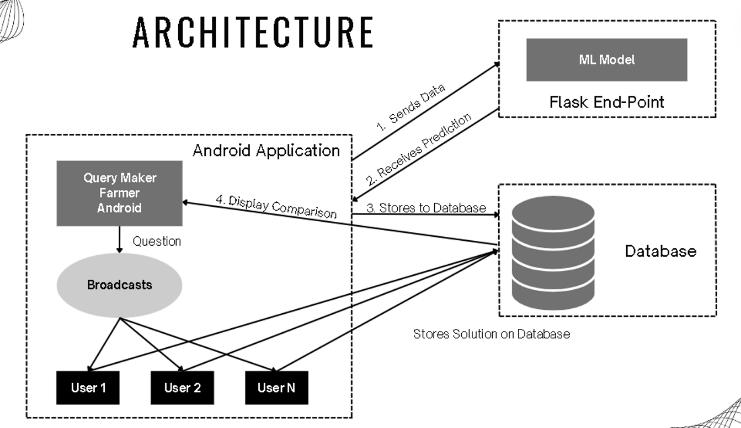
A. Frontend Architecture (Android Application)
The frontend of our system is an android application developed in Java, providing a robust and platformcompatible interface for users. This application facilitates data input by allowing users to upload soil nutrient levels (Nitrogen, Phosphorous,Potassium) andenvironmental data such as temperature, humidity, and rainfall. The backend utilizes Flask, a micro web framework, to manage incoming requests and generate responses. Requests sent from the frontend contain soil and climate parameters, while responses include crop recommendations generated by the machine learning model and predicted minimum selling pricesfortherecommendedcrops.
B. Backend Architecture (Flask API)
The backend architecture of our project is engineered to efficiently manage data flow and computational tasks associated with crop recommendation and estimated minimumsellingpriceprediction.Centraltothisarchitecture is the API built using Python's Flask framework, serving as the primary endpoint for user requests initiated from the Android application. The backend system encompasses severalmodules,including:
1. CropRecommendationModule
2. CropSuitabilityCheckingModule
3. CropMinimumSellingPricePredictionModule
These modules are seamlessly integrated to ensure a cohesiveuserexperienceandupholdsystemmodularity.
Upon receiving the soil and climatic details, the request is directed to the Crop Recommendation Module The Crop Recommendation Module utilizes machine learning algorithms to analyze soil and climatic data, providing farmers with tailored crop recommendations based on environmental suitability. Meanwhile, the Crop Suitability Checking Module cross-references user-provided crop preferences with the recommended crops, ensuring
alignment with farmer preferences. Lastly, the Crop MinimumSellingPricePredictionModuleemployspredictive modeling to estimate the minimum selling price of the recommended crops, aiding farmers in making informed decisions regarding crop selection and profitability. Together, these modules form a comprehensive backend system aimed at enhancing agricultural productivity and profitability. The in-depth explanation for each module is givenbelow:-
1. CropRecommendationModule
Training:
o Data: The module uses a dataset containing soil parameters (N, P, K), temperature, humidity, pH, rainfall,andcroplabels.
o Preprocessing: Data is preprocessed by standardizing featuresusingStandardScaler.
o Model: A Random Forest Classifier is used for its robustness and ability to handle complex interactions betweenfeatures.
Functionality:
o Users input soil and weather parameters into the Androidapp.
o Thebackendserverloadsthetrainedmodelandscales theinputparameters.
o The Random Forest model predicts the most suitable crop(s)basedontheinputdata.
2. CropSuitabilityCheckingModule:
Training:
o This module does not require traditional training but uses predefined thresholds and ranges for various crops.
o Data: Contains crop-specific ranges for N, P, K, temperature,humidity,pH,andrainfall.
Functionality:
o Takes user input parameters and a selected crop name.
o Checksiftheinputparametersfall withinthesuitable rangefortheselectedcrop.
o Provides recommendations for soil amendments if parametersareoutofrange.
3. CropMinimumSellingPricePredictionModule:
Training:
o Data: Historical crop price data (minimum support prices)withyearlyrecords.
o Model: ARIMA (AutoRegressive Integrated Moving Average) model, chosen for its effectiveness in time seriesforecasting.
Functionality:
o Usersinputthecropname.
o Thebackendloadsthehistorical pricedata andtrains anARIMAmodel.
o Themodelforecaststheminimumsellingpriceforthe current year, helping farmers make informed decisionsbasedonexpectedprofitability.

International Research Journal of Engineering and Technology (IRJET) e-ISSN: 2395-0056
Volume: 11 Issue: 11 | Nov 2024 www.irjet.net p-ISSN: 2395-0072
The proposed system demonstrates the synergistic potential of combining AI capabilities with human expertise, providing a comprehensive decision-support system that leveragesbothdata-driveninsightsandlocalknowledge.This approachaimstoenhancecropselectionprocesses,optimize agricultural practices, and ultimately contribute to sustainablefoodproduction.
By integrating advanced machine learning models like Random Forest and ARIMA with human feedback mechanisms,theproposedsystemoffersarobustsolutionfor crop optimization, aiming to improve agricultural practices andsustainability.
The developed Android application for crop optimization, featuring sections for checking crop feasibility, helping cofarmers, and generating reports, has shown promising results.
In the Check Crop Feasibility section, farmers input soil andclimatedata,whichthe RandomForestclassifierusesto predict suitable crops. This model demonstrated high accuracy in real-world tests. The Help Your Co-Farmers section allows farmers to ask and answer questions, integrating local knowledge with AI recommendations. The Reports section combines these insights, providing comprehensive crop feasibility and profitability analyses usingARIMAmodelforecasts.
User feedback indicates high satisfaction with the application's usability and relevance. Comparative analyses show significant improvements in crop yields and profitability when using the application versus traditional methods. The integration of machine learning with human expertise enhances decision-making and supports sustainable agricultural practices. This synergy validates the effectiveness of the proposed system, which will continue to be refined and expanded to further leverage AI and communitycollaborationinagriculture.
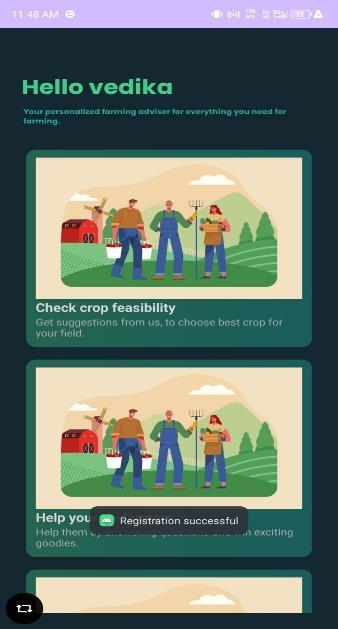
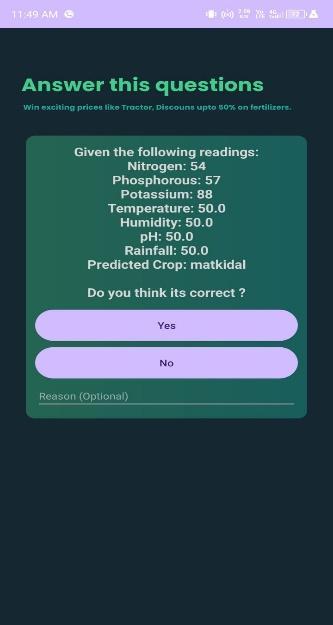
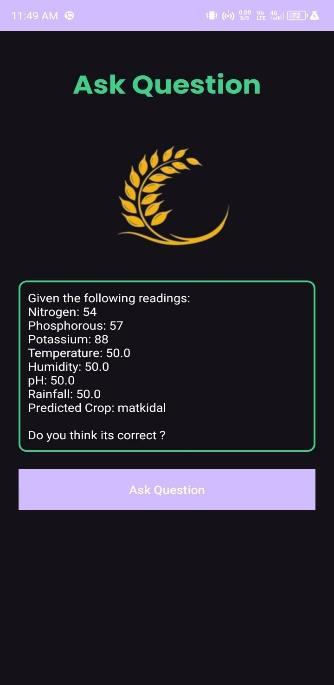
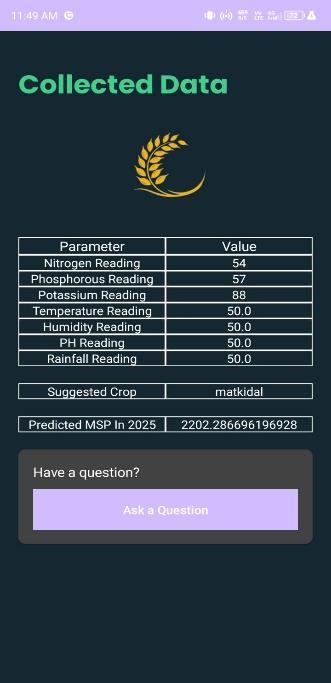
Fig2:AndroidapplicationUI.
In conclusion, our project on "Agricultural IntelligenceBridging Machine Learning and Human Interaction for Crop Optimization" presents a comprehensive approach to enhancing crop selection processes in agriculture. By leveraging machine learning models such as Random Forest and ARIMA, coupled with farmer feedback mechanisms, we have developed a robust decision-support system for assisting farmers in making informed crop selection decisions. Through rigorous evaluation and comparative analysis, we have demonstrated the effectiveness and reliability of our approach in optimizing crop selection, improving agricultural practices,and ultimatelycontributing to sustainable food production. Moving forward, our project

International Research Journal of Engineering and Technology (IRJET) e-ISSN: 2395-0056
Volume: 11 Issue: 11 | Nov 2024 www.irjet.net p-ISSN: 2395-0072
We would like to express our sincere gratitude to our guide, Dr. Ganesh D. Bhutkar, Computer Engineering Dept. VIT, for his invaluable guidance, support, and motivation throughout our project. We are thankful for his constant encouragement and for sharing his expertise in the field of computer science. We also extend our appreciation to the faculty of Vishwakarma Institute of Pune for providing us with the necessary resources and infrastructure to carry out this project. Their support and encouragement have been instrumentalinthesuccessfulcompletionofourresearch.
[1] Bondre, Devdatta & Mahagaonkar, Santosh. (2019). PREDICTION OF CROP YIELD AND FERTILIZER RECOMMENDATION USING MACHINE LEARNING ALGORITHMS. International Journal of Engineering Applied Sciences and Technology. 04. 371-376. 10.33564/IJEAST.2019.v04i05.055.
[2] D. Sawant, A. Jaiswal, J. Singh and P. Shah, "AgriBot - An intelligent interactive interface to assist farmers in agricultural activities," 2019 IEEE Bombay Section Signature Conference (IBSSC), Mumbai, India, 2019, pp. 1-6,doi:10.1109/IBSSC47189.2019.8973066.
[3] A. Sharma, A. Jain, P. Gupta and V. Chowdary, "Machine Learning Applications for Precision Agriculture: A ComprehensiveReview,"inIEEEAccess,vol.9,pp.48434873,2021,doi:10.1109/ACCESS.2020.3048415.
[4] Razali, Mohd Hudzari Haji, Mat Atar, and Siti Norjihah. "Human computer interaction and application in agriculture for education." International Journal of InformationTechnology&ComputerScience2.3(2012): 7-11.
[5] De Silva, L. et al. (2016). Interplay of Requirements Engineering and Human Computer Interaction Approaches in the Evolution of a Mobile Agriculture InformationSystem.In:Ebert,A.,Humayoun,S.,Seyff,N., Perini, A., Barbosa, S. (eds) Usability- and AccessibilityFocused Requirements Engineering. UsARE UsARE 2012 2014. Lecture Notes in Computer Science(), vol 9312. Springer, Cham. https://doi.org/10.1007/978-3-31945916-5_9
[6] Szu-Yu(Cyn)Liu,ShaowenBardzell,andJeffreyBardzell. 2019. Symbiotic Encounters: HCI and Sustainable
| Page131 aimstofurtherrefineandexpandtheplatform,incorporating advancements in machine learning techniques and fostering greater collaboration between AI-driven recommendations andhumanexpertiseinagriculture.
Agriculture. In Proceedings of the 2019 CHI Conference on Human Factors in Computing Systems (CHI '19). Association for Computing Machinery, New York, NY, USA, Paper 317, 1–13. https://doi.org/10.1145/3290605.3300547
[7] G. V. Mantena, S. Rajendran, B. Rambabu, S. V. Gangashetty, B. Yegnanarayana and K. Prahallad, "A speech-based conversation system for accessing agriculturecommoditypricesinIndianlanguages,"2011 Joint Workshop on Hands-free Speech Communication and Microphone Arrays, Edinburgh, UK, 2011, pp. 153154,doi:10.1109/HSCMA.2011.5942384.
[8] Zhang, Y.; Yao, S.; Wang, P.; Wu, H.; Xu, Z.; Wang, Y.; Zhang, Y. Building Natural Language Interfaces Using NaturalLanguageUnderstandingandGeneration:ACase Study on Human–Machine Interaction in Agriculture. Appl.Sci.2022,12,11830.
[9] Lyle, P., Choi, J.Hj., Foth, M. (2013). HCI for City Farms: Design Challenges and Opportunities. In: Kotzé, P., Marsden,G.,Lindgaard,G.,Wesson,J., Winckler,M.(eds) Human-Computer Interaction – INTERACT 2013. INTERACT2013.LectureNotesinComputerScience,vol 8120. Springer, Berlin, Heidelberg. https://doi.org/10.1007/978-3-642-40498-6_7
[10]U. Yunus, M. Rizkiansyah, A. Ariestyani, J. J. Anderson and R. Aricat, "Comparison of Farmers' Experience in Indonesia on HCI," 2021 International Conference on Information Management and Technology (ICIMTech), Jakarta, Indonesia, 2021, pp. 750-754, doi: 10.1109/ICIMTech53080.2021.9535085.
[11]Francisco Gutiérrez, Nyi Nyi Htun, Florian Schlenz, Aikaterini Kasimati, Katrien Verbert, A review of visualisations in agricultural decision support systems: An HCI perspective, Computers and Electronics in Agriculture,Volume163,2019,104844,ISSN0168-1699.
[12]Ibrahim,U.,&Danmaigoro,A.(2024).Human-Computer Interaction in Agricultural User Interfaces. International Journal of Applied and Scientific Research, 2(2), 187–198.
[13]M. Kalimuthu, P. Vaishnavi and M. Kishore, "Crop Prediction using Machine Learning," 2020 Third International Conference on Smart Systems and Inventive Technology (ICSSIT), Tirunelveli, India, 2020, pp.926-932,doi:10.1109/ICSSIT48917.2020.9214190.
[14]Elbasi, E.; Zaki, C.; Topcu, A.E.; Abdelbaki, W.; Zreikat, A.I.; Cina, E.; Shdefat, A.; Saker, L. Crop Prediction Model Using Machine Learning Algorithms. Appl. Sci. 2023, 13, 9288.
2024, IRJET | Impact Factor value: 8.315 | ISO 9001:2008